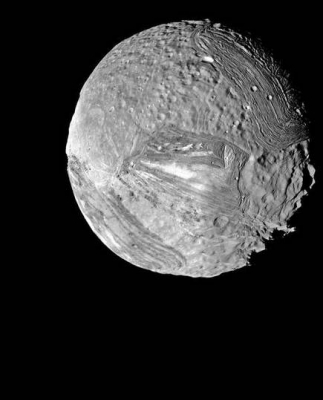
Either now, or when you were younger, you would have surely played with jigsaw puzzles. But have you ever tried to piece together parts from different puzzles and see what you can end up with? What if the same thing actually happened on a celestial scale? The result probably would look something like Miranda.
One of Uranus’ five major moons, Miranda is the innermost and smallest among them. It was discovered by Gerard P. Kuiper on February 16, 1948 in telescopic photos of the Uranian system. Kuiper worked at the McDonald Observatory in western Texas and the photos were obtained using the Otto Struve Telescope at the University of Texas in Austin.
Shakespeare connect
Weeks within its discovery, Miranda’s motion around Uranus was confirmed, on March 1, 1948. With Uranus’ previous moons Ariel and Umbriel discovered in 1851, this made Miranda the first satellite of Uranus to be discovered in nearly 100 years.
Like Uranus’ other major moons Oberon, Titania, Ariel and Umbriel, Miranda’s name too was related to the works of English poet William Shakespeare. Miranda was named for the daughter of Prospero in Shakespeare’s play The Tempest.
At about one-seventh the size of our Earth’s moon, Miranda is among the smallest objects in the Solar System to have achieved hydrostatic equilibrium. Taking 1.4 days to complete an orbit around Uranus and with an orbital period that is also 34 hours, it is tidally locked with Uranus and hence has the same side facing the planet at all times.
Five features
What makes Miranda mysterious, however, is the fact that it has one of the weirdest and most varied landscapes among all extraterrestrial bodies. Scientists agree upon at least five types of geological features on Miranda. These include craters, coronae (oval-shaped features), regiones (areas strongly differentiated in colour or albedo), rupes (scarps or canyons) and sulci (complex parallel grooved terrain).
There are younger, lightly cratered regions and older, heavily cratered regions on Miranda. There are three large coronae in the southern hemisphere, which are kind of unique among objects known in the solar system. These racetrack-like grooved structures are named Arden, Elsinore and Inverness, all locations in Shakespeare’s plays.
Largest cliff in Solar System
The largest known cliff in the Solar System is on Miranda and is known as Verona Rupes, named after the setting of Shakespeare’s Romeo and Juliet. With the cliff face estimated to be 20 km high, this rupees is as many as 12 times as deep as the Grand Canyon in the U.S.
As Miranda is almost invisible to most amateur telescopes, almost everything we know about it is through the Voyager 2 mission. The only flyby of the Uranian system so far was achieved by Voyager 2 in 1986, providing us with a sneak peek of Miranda’s geology and geography.
Considering only the southern hemisphere of Miranda faced the sun during Voyager 2’s flyby and the northern hemisphere was in darkness, only the southern hemisphere has been studied to some extent. Theories have been proposed and discussed as to what might be the reasons for Miranda’s varied geological features. But these mysteries will be solved only with more information and that might well require further missions to Uranus and its system.
Picture Credit : Google

